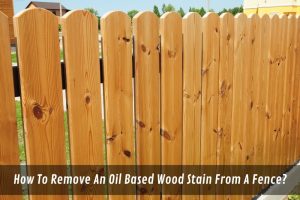How To Remove An Oil Based Wood Stain From A Fence?

Have you accidentally stained your fence with oil-based wood stain? Don’t panic – it’s not the end of the world! With the right tools and techniques, you can remove the stain and restore your fence to its former glory.
Maintaining a fence can be a challenging task, especially when you encounter unpleasant surprises like an oil-based stain. These stains can be stubborn and difficult to remove, requiring some special measures for bringing your fence back to its original condition.
If you’re not sure about how to remove an oil-based wood stain from your fence, this article is for you. We’ll guide you through the steps to help you take care of your fence and keep it looking great. Let’s get started!
Which oil-based wood stains are removable and which are not?
The removability of oil-based wood stains depends on the type of stain and the method used for removal.
- Penetrating oil-based wood stains seep into the wood fibres and are more challenging to remove than surface oil-based wood stains, which sit on top of the wood surface. If you need to remove a penetrating oil-based wood stain, you may need to use harsher chemicals, such as paint strippers or sanding, which can damage the wood surface.
- Surface oil-based wood stains, on the other hand, can be removed more easily using solvents or wood cleaners specifically designed for this purpose. If you need to remove a surface oil-based wood stain, you can try using a wood cleaner or mineral spirits to dissolve the stain and then wipe it away.
In general, it is always a good idea to test a small, inconspicuous area of the wood before attempting to remove a wood stain, regardless of whether it is oil-based or water-based. This will help you determine the best course of action and minimize the risk of damaging the wood surface.
What are the necessary tools and materials required for removing oil-based wood stains?
To remove oil-based wood stains, the following tools and materials are typically necessary:
- Protective gear
Wear gloves, eye protection, and a face mask to protect yourself from the chemicals in the stain and the fumes.
- Paint stripper
Choose a paint stripper that is specifically designed to remove oil-based stains. Look for a product that is safe to use on wood and is formulated for outdoor use.
- Scraper
Use a scraper to remove the loosened stain. A plastic scraper is a good option to avoid damaging the wood.
- Sandpaper
Sand the wood with fine-grit sandpaper to remove any remaining stains and smooth the wood’s surface.
- Pressure washer
A pressure washer is helpful for removing the stain from large areas such as a fence. Be sure to use the appropriate pressure setting to avoid damaging the wood.
What are some tips and tricks on how to make the process easier and more efficient?
If you’re looking to stain your fence, here are some tips and tricks to make the process easier and more efficient:
- Prepare the surface: Before applying any stain, make sure to clean the fence thoroughly to remove any dirt, grime, or previous coatings. If there is an old varnish or stain, you may need to use a chemical stripper to remove it. Once the surface is clean, you can sand it to smooth out rough areas.
- Choose the right stain: There are various types of fence stains available, including water-based stains and oil-based stains. If you’re looking for a natural wood look, a water-based stain that enhances the natural grain of the wood may be your best bet. Wattyl stain and varnish is a popular option that provides excellent protection and a beautiful finish.
- Use the right tools: A garden sprayer is a convenient tool for applying fence stain. It helps to evenly distribute the stain and reduces the amount of time and effort required to complete the task. You may also need brushes or rollers to work the stain into tight spots or for touch-ups.
- Be mindful of weather conditions: Make sure to check the weather forecast before you start staining your fence. Ideally, the temperature should be between 50-90 degrees Fahrenheit and the humidity should be low. Avoid staining your fence during rainy or windy conditions, as this can affect the quality of the finish.
- Use oxalic acid for tough stains: If there are tough stains or discolourations on the fence, you can use oxalic acid cleaner to remove them. This is a powerful cleaning agent that can lighten the colour of the wood. So be sure to follow the manufacturer’s instructions carefully.
- Visit a hardware or home improvement store: For any questions or guidance, don’t hesitate to visit your local home improvement or hardware store. They can provide advice on the best products to use. As well as any tools or equipment you may need to get the job done right.
Conclusion
Overall, removing an oil-based wood stain from a fence can seem like a daunting task. But, with the right preparation and guidance, it can be done quickly and easily. Just make sure to familiarise yourself with the products and techniques you’ll need to use. Also, take safety precautions and follow up with a sealer for extra protection. With these tips, you can help restore your fence back to its natural colour and enhance the look of your exterior.
If you’re still unsure about how to remove the stain from your fence, don’t hesitate to reach out to a local professional for assistance. Our team can provide assistance with painting fences, doors, windows, and other interior timber. Contact us today to get started on your home improvement project!
